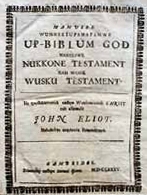Forty-two years after Massasoit joined the Pilgrims in a Thanksgiving feast at Plymouth, the first Bible published in the New World was printed in a Native American language in Cambridge in 1685.
The Bible was the brainchild of the Rev. John Eliot, known as "the apostle to the Indians,"who started preaching to Native Americans of the Massachuset tribe in their own language of Algonquin in 1646. The transliterated text allowed other English-speaking ministers to follow his example. Rev. Eliot came to Massachusetts Bay in 1631 on the ship Lyon (the 60 passengers included the wife and children of Gov. John Winthrop) and served as minister of the First Church of Roxbury for almost 60 years.
A second edition of the Eliot Indian Bible was published in 1685, a copy of which was presented to the MIT Libraries rare book collection in 1972 by I. Austin Kelly III (SB 1926). The extremely valuable book, kept by the Institute Archives and Special Collections, is in delicate condition and must be handled gingerly by staff and patrons wearing soft white cotton gloves.
Although people are urged to use microfilm versions of the Bible to cut down on the wear and tear of the fragile pages and binding, arrangements can be made to see the original. This requires making an appointment by calling the Archives at x3-5136 or sending e-mail to mithistory@mit.edu.
Because Rev. Eliot's knowledge of Algonquin was limited, the first edition contained many grammatical mistakes and English words. The second edition corrected these errors. Most copies of the first edition were destroyed during King Phillip's War in 1675-76 during which most members of the Native American tribes of southern New England were killed, enslaved or forced to flee.
Two Native Americans, preacher John Nesutan and printer's apprentice James Printer, helped Rev. Eliot with the translation. Mr. Printer fought against the colonists in the war and was taken prisoner. He resumed his career after the war. Mr. Nesutan, who had attended Harvard University, sided with the colonists and was killed in the war. Rev. Eliot died in 1690 at age 86.
A version of this article appeared in MIT Tech Talk on November 22, 2000.






